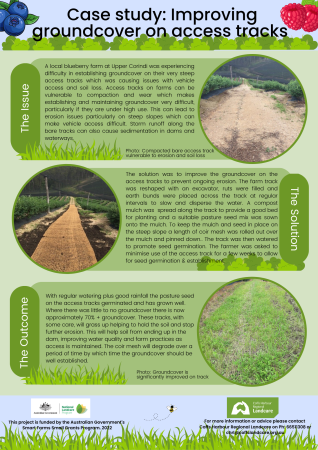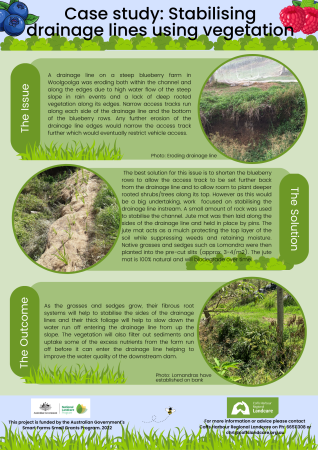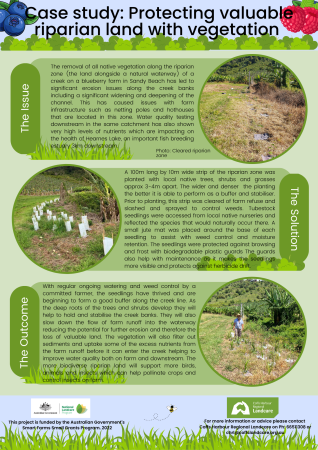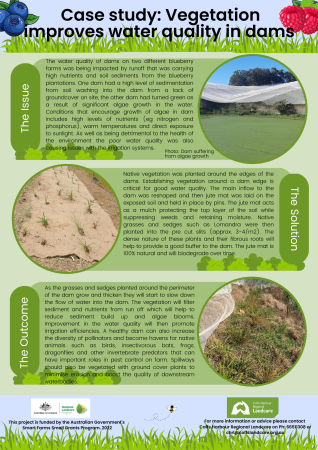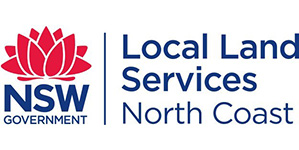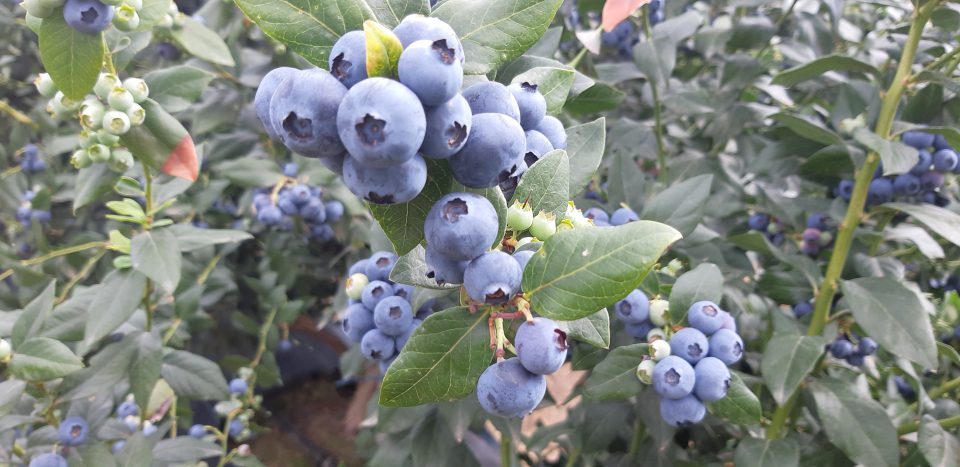
Groundcover and Vegetation Best Management Practice for Intensive Horticulture Farms in Coffs Harbour
Coffs Harbour Regional Landcare was successful in receiving a Smart Farms Small Grant from the Australian Government in 2019. The aim of Smart Farms is to provide funding to organisations and individuals to undertake sustainable agricultural projects and build the capacity and capability of farmers to adopt best practice natural resource methods.
Our project titled ‘Groundcover and vegetation Best Management Practice for Intensive Horticulture Farms in Coffs Harbour’ aims to improve on farm soil health and prevent soil and nutrient loss from farms into the natural water systems by improving on farm vegetation cover.
Project outcomes
- Reduced soil movement on and off farm through the establishment of groundcover and vegetation through best management practices.
- Improved on farm soil health
- Improved off farm water quality
- Improved capacity and capabilities of farmers to assess and improve their on farm vegetation cover to make their farming systems more sustainable
- Written and visual materials on on farm vegetation Best Management Practices created including Project case studies and Video.
The intensive horticulture industry in Coffs Harbour has rapidly expanded over recent years. It is mainly dominated by blueberries grown as field crops and raspberries, cucumbers and tomatoes that are grown in tunnel/hothouses. Many of these intensive horticulture farms are located on the steep slopes of old banana plantations with blueberries planted on the slopes. Hothouses are generally constructed on flat areas at the bottom of the slope usually directly adjacent to a watercourse. However as the popularity in protected cropping increases significant soil excavation is occurring to cut flat pads out of the slopes. Considerable modification and clearing of the land are required for both of these growing systems and generally result in significant areas of bare earth and the absence of riparian vegetation buffers. This contributes to soil and nutrient loss via runoff into local waterways. CHRL has been working with intensive horticulture farmers since 2012 to try and address these issues. Recent research by Southern Cross University on water quality in local waterways directly associated with intensive horticulture farms has shown that significant soil sediments and nutrients are leaving these farms in water run-off and are impacting on downstream aquatic ecosystem health including the Solitary Island Marine Park just off the Coffs Coast.
Through this project CHRL was able to demonstrate and implement best management practices for improving ground and vegetation cover on intensive horticulture farms in the Coffs Harbour region to prevent soil loss and improve water quality both on and off farm. Six intensive horticulture farmers were engaged to participate in this project all either growing infield blueberries or a combination of infield blueberries and hothouse crops. Initial on farm groundcover/ vegetation health assessments were completed across the six properties at the beginning of the project to provide an understanding of the current on farm conditions and develop recommendations for improvements to guide the onground work component. Onground works were then implemented in high priority areas using the following best practice techniques. Activities varied for each farm.
Groundcover improvement on access tracks and inter rows – groundcover was improved on these by reshaping and filling in ruts or washouts with soil or rocks. Earth bunds were placed across the tracks at regular intervals depending on slope to slow down water flow and disperse it onto grassed water disposal areas off the sides of the track. A compost mulch was then spread along the length of the track and seeded with a suitable pasture mix. Coir mesh was rolled over the top of the mulch and pinned down to keep the mulch and seed in place.
Planting to stabilise drainage lines and improve water quality – where required some minor earthworks and rock were used to stabilise eroding channels. Jute mat was then laid and pinned down along the edges of the drainage lines and local native grasses and sedges were planted densely into it. As these plants grow their fibrous roots will help hold the soil together and their dense foliage will help to slow down water flow and intercept sediment and nutrients in run off before it can enter the drainage line. The jute mat acts as a mulch protecting the top layer of soil while suppressing weeds and retaining moisture.
Planting to buffer riparian zones – Following weed control to reduce competition, endemic native tree, shrub and groundcover tubestock seedlings were planted directly along the riparian zone of a natural waterway at 3-4m spacings to provide a protective buffer. The deep roots of the trees and shrubs will help to hold and stabilise the creekbanks. They will also slow down run off and filter out sediments and excess nutrients before they can enter the creek.
Planting to buffer dams – Native vegetation consisting of grasses, sedges and shrubs were planted into jute mat around the perimeter of dams suffering significant algae growth or sedimentation to help improve the water quality. Jute mat was used to help retain soil & moisture and reduce weed growth therefore reducing the requirement for maintenance.
In total across the six farms, groundcover was improved along 300m of access tracks and 650m of drainage line/ riparian zone and 2 dams were stabilised and buffered using 2500 native plants. This has resulted in improved soil retention on farm, improved water quality both on and off farm, and in the case of the native plantings improved biodiversity which will help farm production by providing habitat for pollinators and natural predators of crop pests.
The implementation of these best practice strategies on ground to increase groundcover and vegetation on farm has provided farmers with management tools that they can use moving forward to protect their soil and water quality, improving farm production and increasing resilience to adverse weather conditions. Awareness raising and capacity building was extended to a greater number of local farmers through their attendance at our on-farm Field Day in April 21 where they were able to see first hand some of these best practice strategies. The development of the four case studies and video created from this project will also continue to inform farmers into the future.
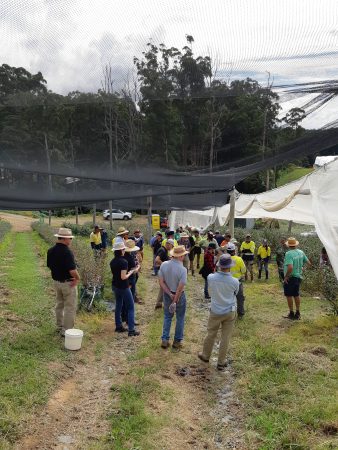
Field Day on participating local farm April 2021
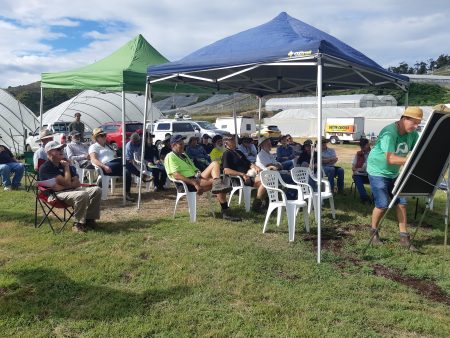
The on-farm groundcover/ vegetation health assessment was re-measured using a one metre quadrat across 56 sites on the six participating properties at the end of the project period in Jan/ Feb 2023. Each of the original sites were revisited and reassessed to make comparison and to see whether there were noticeable improvements since the project began.
Photos were also taken prior to on ground works occurring, as works were occurring, after works had occurred and at various intervals throughout the remainder of the project period. These provide a record of the works done and how they have progressed over time.
Participants at our Field day were also asked to fill in an evaluation form at the end of the day as a way of measuring what they had gotten out of the day including whether they would do something differently on their farm as a result of attending the day.
The most significant outcome of our project was the overall improvement in groundcover and vegetation condition across all the farms. The follow up on-farm groundcover/ vegetation health assessments showed significant improvement at the majority of the sites across all 6 properties with many moving into the ‘good condition’ category from either a ‘poor’ or ‘moderate’ condition. There were a number of reasons for this 1) Improvements as a result of the on-ground works completed as part of this project 2) Improved farm management by the farmers 3) Good growing conditions (ie rainfall) over the last couple of years.
All six farmers were introduced to new ways of addressing soil loss and water quality issues through promoting groundcover and restoring native vegetation. There was already a reasonable understanding of the importance of groundcover to prevent soil loss but the planting of native trees, shrubs and grasses along riparian zones, drainage lines and dams was a big shift in a mind set where vegetation clearing not restoration planting is the normal practice. This project has hopefully improved their appreciation of the importance of natural vegetation on farm and help with better planning and vegetation management into the future.

This project is funded by the Australian Government’s Smart Farms Small Grants Program. Smart Farms Small Grants support sustainable production, productivity, and best practice natural resource management to protect soil, biodiversity & vegetation.
